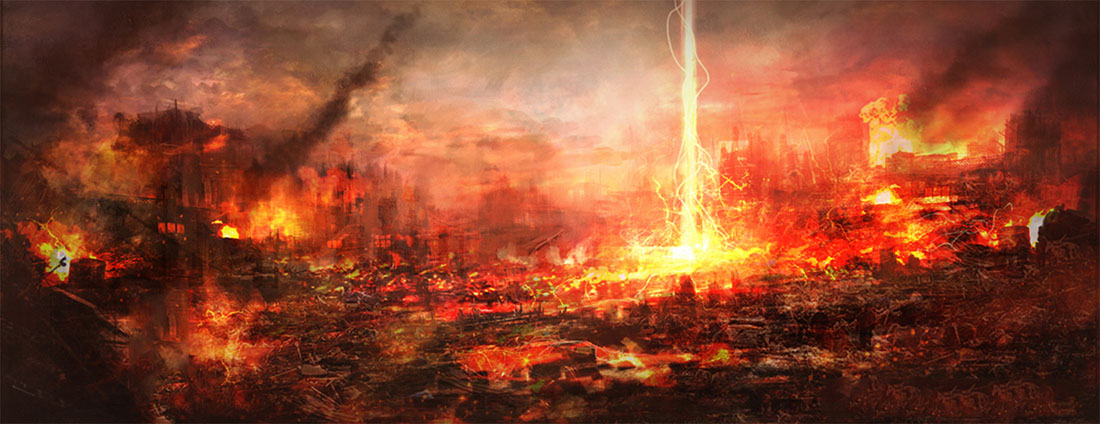Go to Eternal Lies: The Alexandrian Remix

Campaign Notes – Diorama – Props Packet
SPOILER WARNING
Eternal Lies is a truly amazing campaign. When it comes to spoilers, however, it is remarkably fragile. Two words, in particular, can really ruin the whole experience: One is the true name of the Liar. The other is the actual title of the final chapter.
I’ve done my best, even while sharing my notes for remixing the campaign, to NOT use those words in these semi-public posts. (Or, at least, not use them in a context that would reveal their significance.) However, now I need to discuss running the finale of the campaign and that necessarily carries with it the need to get a little riskier. The best I can do is to simply add another ablative layer of spoiler warnings.
SPOILER SPOILER SPOILER
Seriously. If you’ve landed on this page and you’re not 100% sure you want the Eternal Lies campaign spoiled for yourself, you should really stop reading.
…
Okay, that’s the best I can do.
(For similar reasons, I didn’t label the final set of my notes in my binder for the campaign in order to minimize the risk of my players accidentally seeing the title.)
SEQUENCE 1
The most important part of this sequence, in my opinion, is the beginning: Triumph Atop Mt. Kailash. The players may have some nagging doubts about the vision they just received, but it’s really important that they also feel a legitimate sense of having won.
Towards that end, I’ve added an actual mechanical reward here to emphasize the moment.
Once you’ve built them up (and, just as importantly, let them build themselves up and celebrate), you’re ready to start revealing the growing horror of what’s happening around them.
SEQUENCE 2
I’ve discussed the general theory behind this sequence in my introduction to the remix. The idea is that there are four thematic concepts that make up the REVELATION:
- Great power requires great sacrifices
- Edgar Job played a key role in Echavarria’s ritual
- Echavarria’s ritual had two layers
- Azathoth was the true focus of Echavarria’s interest
The specific details listed in these remix notes are specific to my PCs. They reflect the events that (a) actually happened in our play-thru of the campaign and (b) which seemed to have particular resonance for my players. For your campaign, you’ll want to similarly construct a personalized Revelation.
The timing of using the Revelation is more of an art than a science: With the additional data point of the Liar’s final vision (plus the horrible things happening around them), it’s not impossible for the players to figure out what’s happening. (Particularly if they’ve asked certain questions of Gol-Goroth or if they’ve paid particular attention to certain volumes in Echavarria’s library.)
When this happens also depends on exactly when your players start falling into a serious discussion about what they’re seeing and what they think happened. My players started that midway down their descent of the mountain. Other groups might get all the way to Darchen or even Burang before they start trying to figure it out. My suggestion is that you want to hold off on pushing for the Cthulhu Mythos spend until after they’ve realized that the problem is global in scope. (In other words, let all the Mythos stability checks in Sequence 1 play out.) Once that’s happened, play it by ear and then tell them the Cthulhu Mythos spend is both available and, if they can’t figure it out on their own, required.
(If they proactively ask for the Cthulhu Mythos spend, of course, you can just go with it whenever they request it.)
SEQUENCE 3
In order for the Apocalypse to be effective, I believe that it has to be personal.
As a result, the Scenes from the Apocalypse that you’ll find in my remix notes are, once again, very specific to my PCs and the things that they had experienced up until this point:
- Ulysses had a close encounter with a Hound of Tindalos in the original back story for his character. It made sense to bring that full circle as the barriers between dimensions collapsed. Robert’s visitation from the dead was a similar callback. (You might consider looking back at the original character backgrounds to find elements for use in your apocalypse.)
- The PCs had rescued Monte and Alexi from Malta and taken them to Paris to be cared for by a Source of Stability. (Monte’s cure as a result of destroying the Liar was also a good way to remind them that defeating the Liar had been a triumph, even if its unintended consequences were horrific.)
- One of the PCs was from Chicago and had a Source of Stability there. (This kind of remote news that they can’t really do anything about is a good way of emphasizing how widespread and catastrophic things are.)
- The PCs had gotten Janet Winston-Rogers to set up a safehouse for loved ones who had been threatened by the cult.
- The death of Frank Kearns was a good opportunity to emphasize the emotional trauma being suffered by civilians in the setting. It also makes the death and destruction personal.
(In actual practice, these elements played out in delightfully unexpected ways: The PCs reached Paris. They learned that the boys had been evacuated to England and that Chicago was burning. They were chased back to their plane by a cannibalistic mob. Deciding that time was running out, they bit the bullet and used the Create Hyperspace Gate spell to jump directly to Savannah. As they left, however, they told Frank Kearns that they needed him to get their plane safely back to New York and check on their loved ones… which gave him enough sense of purpose to avoid giving into despair before they had managed to save the world.)
The published campaign has an interesting grab-bag of apocalyptic imagery (some of which I summarized at the beginning of this sequence of this remix as a grab bag from which I could improvise additional and/or alternative scenes if the PCs took a radically different route than I was anticipating).
SEQUENCE 4 & FINALE
As I noted above, my PCs used the Create Hyperspace Gate spell to go directly to Savannah. I decided that the dimensional disruption around Edgar Job would force them to appear on the outskirts of town so that the Into Savannah sequence would still play out. It may not be entirely clear from my notes, but the asynchronous appearances of the Feral Child in this sequence are meant to be intermixed around the other moments.
EPILOGUE
As a final note, the epilogue of the campaign — with its cycle of three questions for each player — is brilliantly conceived and provided a note-perfect conclusion to an immersive and emotionally-wrenching campaign.













Hi Justin, it looks like the diorama zip file behind the link is corrupted. No need to make this comment public.
Looks like the upload got corrupted. Re-uploaded, downloaded, and tested it. If anyone still has a problem with it, please let me know!
“As a final note, the epilogue of the campaign — with its cycle of three questions for each player — is brilliantly conceived and provided a note-perfect conclusion to an immersive and emotionally-wrenching campaign.”
==> Sounds very interesting. Is there any chance you could elaborate upon this section and the ‘three-questions-approach’? It’s important to provide satisfactory conclusions to adventures, chapters and campaigns, but I haven’t been able to find much advice regarding this aspect of DM’ing yet.
Hi Justin, you probably have a ton of other stuff to do and lost track of the comments, but I’m really curious about how you tackled the epilogue as explained in my comment above. If you could find the time to elaborate, I’d appreciate it very much.
Basically, you ask each player what their life looks like a month after the end of the campaign. Once everyone has answered, you ask them about a year later. And then you do a final cycle asking them about what happens a decade later.
There are some additional details specific to the Eternal Lies (and, similarly, you’d want to customize the epilogue to fit any campaign).
This would not be the perfect ending for every campaign. But it works very, very well for this campaign.
Okay, thank you – much obliged! 🙂 Simple enough, but a good idea to bring satisfactory closure to a long-running campaign (some, at least).
No idea if you’re still reading these comments, but I wanted to commend you on the great job that you did on this remix. Its quality is stunning. I found it after running the Waterdeep: Dragon Heist remix you made and I’m super impressed with the thought and care you put into these.
I’m tempted to supply more evidence about Job’s role in the ritual to the point where players would have at least a small chance in averting the apocalyptical scenario in this chapter, likely by killing him. As written, I can’t help but feel like I’d feel screwed over by the GM/Campaign with the world nearly ending right after I supposedly did everything right, very likely with already great consequence to myself or loved ones.